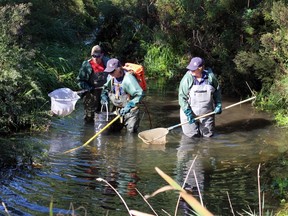Presence of cold-water species was an ‘excellent’ find, says biologist

Although counting fish sounds like a job that could get pretty monotonous, Erin Carroll doesn’t think so.
Advertisement 2
Article content
Carroll, an aquatic biologist with the Upper Thames River Conservation Authority, was doing just that at a small creek northeast of Stratford on a weekend morning in early October.
“It doesn’t get old,” Carroll said “We’re always finding new things. It’s one of the wonders of nature that you can go out to the same place routinely and always find something new.”
Carrying what looked like a bright orange backpack, Carroll, along with assistant aquatic biologist Dave Johnson and local farmer Brad Wilhelm, used a method of “electric” fishing that, using an anode and cathode, temporarily stunned the fish. This, Carroll noted, is the least harmful way to allow the counting to happen.
While the Avon River watershed received a D grade in the conservation authority’s most recent watershed report card, this particular spot was healthy, as evinced by a large presence of brook trout, mottled sculpture and pearl dace.
Advertisement 3
Article content
“All these things together are showing that we’ve got a really nice, healthy system here, and that is really because of the local landowners who have done such a good job to look after this stretch of the creek. It’s got healthy, riparian vegetation, which is providing shade and cooling the system,” said Carroll, who has worked for Upper Thames River Conservation Authority for about two years..
Brook trout in particular are an important indicator since its’s what’s called a sentinel species, meaning, in this case, its presence indicates pristine water. The species, though, has seen a steep decline in the region, with roughly 80 per cent of its population disappearing from the watershed over the past 50 years, Carroll said.
Advertisement 4
Article content
“Seeing a variety of males and females in different sizes in the upper Avon was excellent,” Carroll said.
The day was particularly satisfying for Craig Merkley, a retired conservation services specialist with the authority. Thirty years ago, he banded together with several local landowners under the slogan of “neighbors helping neighbors” to plant trees and shrubs on their farms. Tree planting is “very crucial” to helping improve local water quality, Merkely said. He estimates there has been between 15,000 to 20,000 trees planted in that area over the years.
“This has kind of it’s been a long time coming, but we’ve got the tools now to monitor what we started many years ago. As you can see, it’s very satisfying, and the landowners who originally started it way back when, are all still here. They’re part of it, and it’s very exciting and satisfying for them to see the results of their work over the years,” said Merkely, who still volunteers with the Upper Avon River Conservation Club.
Advertisement 5
Article content
Local farmers are critical to both protecting the watershed and allowing the conservation authority team to do its count, Carroll said.
“These creeks and rivers wind through private property so. without willing landowners, we wouldn’t be involved. It really starts with landowners,” she said.
One of the challenges facing the Upper Thames River Conservation Authority is the presence of invasive species, particularly carp and goldfish. These non-indigenous species compete with native species for food sources and often reproduce more quickly, which threatens species that all already in decline. This can be particularly challenging given there is no effective method of eradication, Carroll said.
Goldfish, for example, can even burrow into the mud at the bottom of a pond, making them difficult to find.
Advertisement 6
Article content
“So we just don’t have an effective way to remove them once they’ve been introduced,” Carroll said.
While the count provides a snapshot in time of the types of fish found that day, they don’t tend to move very far over their lifespans, Carroll said.
“So if we’re seeing the mottled sculpin and the pearl dace, we know that this water is cold enough and clean enough to support them year-round. So it is really an indication of a healthy river system because these are the first species to disappear when things go wrong,” Carroll said.
Having never visited that site before, Carroll was pleasantly surprised with what they found.
“I didn’t know what we were walking into. . . . Just to see a variety of sizes of brook trout and the other cold-water species. . . was just an excellent finding. (But) that’s not the story everywhere we go, but that was one where it really was a good news story,” she said.
Article content